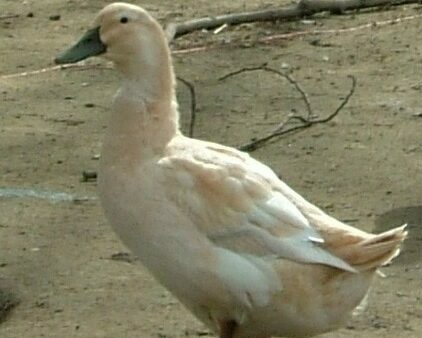The Golden Cascade Duck is a breed of domesticated duck that has a great egg-laying ability and was developed as a dual-purpose breed. This duck has a unique cream and tan coloring, is used for both meat and egg production, and is popular as a backyard duck for ornamental purposes.
This medium-sized duck is popular throughout the United States and was only recently introduced into the market. They were given their name for their unique golden appearance which makes them stand out against other ducks as pets.

Quick Facts About Golden Cascade Ducks
| Breed Name: | Golden Cascade |
| Place of Origin: | United States |
| Uses: | Eggs, meat, pets |
| Drake (Male) Size: | 7–8 pounds |
| Duck (Female) Size: | 6–7 pounds |
| Color: | White, cream, tan, fawn, golden |
| Lifespan: | 10–12 years |
| Climate Tolerance: | Adaptable to cold and heat |
| Care Level: | Easy |
| Production: | Eggs and meat |
Golden Cascade Duck Origins
The Golden Cascade duck was first developed in 1979 in the United States by David Holderread, who wanted to produce a duck that was a fast grower and a great egg layer. The breed was later introduced into the market in 1984 where they were used for dual purposes—but primarily for egg production.
Today, they are popular ducks that can be found on farms or raised in your backyard. Golden Cascade ducks can also be found in the wild where they can handle all climates with the four seasons. This duck breed has not yet been admitted to the American Poultry Association’s standards of perfection because it is still a relatively new breed.
Golden Cascade Duck Characteristics
Golden Cascade ducks have many desirable characteristics that have led them to become a dual-purpose breed in the egg and meat industry. They are docile and fast-growing birds that weigh between 6 to 8 pounds as an adult. They grow to medium size with males being larger than females. You will find that Golden Cascade ducks are quite active and enjoy exploring their environment and interacting with one another.
The most distinct characteristic of these ducks is their fast growth which makes them able to mature more quickly to lay eggs and be used for meat. Their poor flight ability makes them able to live in fenced-off areas without you having to worry about them flying away. The ducklings can leave the nest only a few days after being born and are quite active.
- Active
- Docile with a good temperament
- Fast growth
- Medium-sized body
- Able to live in all climates that experience the four seasons
- Produce well-formed eggs
- Are not aggressive towards other ducks
- Great swimmers
Uses
The Golden Cascade duck is a dual-purpose breed which means they can either be used for meat and egg production or kept as pets for ornamental purposes in a garden. They lay well-formed eggs and have high-quality meat. Since they are docile and playful with an attractive appearance, many duck lovers will keep this duck breed as pets in their backyard and may choose to not use them for meat and only their eggs. They can lay up to 260 white or blue eggs a year from January to August, which makes them decent egg layers.
Appearance & Varieties
The Golden Cascade duck was named for the golden hue that covers their predominantly white bodies. The golden coloration in this duck breed is due to the brown sex-linked recessive gene that covers their bodies, along with a red tint on their head.
The Golden Cascade duck can vary in coloration depending on their age and gender, with females having buff or fawn-colored feathers mixed in with their creamy white bodies with orange beaks, bright white underbody, reddish-brown breasts, and patches of brown shades over their back. Both male and female Golden Cascade ducks may also have a statin green or bronze tinged head, however, the males have a white ring on their necks. Older drakes (males) can molt to a buff or fawn color on their bodies and head, and their throats can turn a light brown color.
The ducklings have a slightly different coloration before they are fully grown and over 1 year of age. The ducklings typically have a chestnut-colored chest with a golden buff color over their bodies, white sides, and shoulders, and a white underbelly that they will maintain as they grow.
Population/Distribution/Habitat
The Golden Cascade duck was first bred in the United States; however, they can be found worldwide in a variety of different climates. They make good backyard ducks that can be raised as pets in a garden with a secure fence, shelter, and a small pond because they like to be in the water, especially on hot summer days. Since this is a domesticated breed of duck that does well in the egg and meat industry, they are also kept on commercial farms.
There are sightings of Golden Cascade ducks in the wild, however, most of the population is on farms within the United States.

Are Golden Cascade Ducks Good for Small-Scale Farming?
This duck breed is excellent for small-scale farming because of its good egg-laying abilities and quality meat. They are easy to keep on farms and grow relatively quickly with good breeding habits. They can lay nearly 300 eggs a year, which makes them desirable for egg farming. You can keep a group of these ducks with a proper male-to-female ratio and let them reproduce naturally or keep a group of female Golden Cascade ducks for egg production for food.
Featured Image Credit: Golden_Cascade_female (Image Credit: Antheat, Wikimedia Commons CC SA 3.0 Unported)
